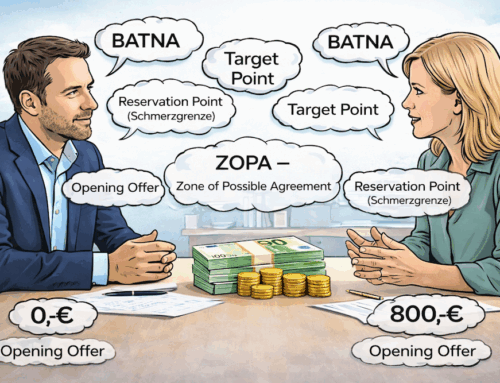The evaluative mediation style (1/4) – Evaluative mediation services
Evaluative and proven activities of mediators in mediations
Blog series on evaluative mediation
- Evaluative mediation services. Evaluative and proven activities of mediators in mediations
- Legality of evaluative mediation activities.
- Mediation appropriateness of evaluative mediation activities. Mediation principles as a framework for evaluative mediation services.
- Opportunities and risks of evaluative mediation services. Do it!
Introduction
Mediation styles can be categorised and classified in different ways. This is of course helpful in order to be able to emphasise the various aspects that should be emphasised. However, it is not easy to find or establish a binding vocabulary and understanding for the individual mediation styles themselves.
This blog has already discussed the possibilities of a Map for mediation styles has been presented. Reference is made to this here.
- Riskin's Grid. Maps of mediation (1/3)
- Meta-model of mediation by Nadja Alexander Maps of mediation (2/3)
- Basic ideas of mediation as a map for localising mediation styles. Maps of mediation (3 of 3)
The following article will therefore focus solely on those areas of activity that are generally and sometimes resolutely rejected by other styles of mediation, but which are desired, demanded and carried out as part of evaluative mediation activities.
Range of evaluative mediation activities
Evaluative activities, i.e. evaluative work, can best be localised for mediators if one considers the range of activities in total which neutral third parties can in principle carry out.
On the one hand, third parties can merely moderate, accompany the communication process and intervene as little as possible„.
You would be on a even lower, but effective level can also simply be present without having to communicate anything beyond your presence and attention. Anecdote: In the English Premier League in the 1990s, there was a project to improve fan and stadium culture: Some of the mothers of the hooligans (football fans) were recruited as supervisors in the fan block and were able to calm the aggressive moods of the fans a little. This approach has since been adopted in other leagues (Brazil). This is just one specific example of the experience that aThird parties present can have a socialising effect on parties to a dispute.
Moderating third parties take up and structure the topics and communication contributions of the conflict parties, sort them and then allow for more in-depth contributions. They ensure that the parties involved in the conflict (can) communicate in a moderate manner, prevent derailments and interruptions and encourage an exchange of views. Mediators who provide support in this way do not force communication, but do not allow it to dry up either.
In the complete In contrast, neutral third parties act decisivelycan, should and must make a decision based on a neutral standard, which is then binding on the parties involved. This function of a third party is assumed by the Judge. A decision is made neutrally and impartially on the basis of a standard that is independent of the conflicting parties. In a constitutional state in which a state judge acts, it is the standard of law.
Sog. Conciliator have the task, as a neutral third party in a dispute, of finding an – acceptable – solution for all sides; to propose a solution, which can then be examined by the parties to the conflict and accepted or rejected as appropriate or inappropriate.
With these basic categorisations of neutral third parties, individual activities of evaluating mediators can be listed below.
However, when approaching the pros and cons of mediator-evaluative activities, it is essential to bear in mind that the Very different fields of application for mediators are:
- A lawyer-mediator in a commercial mediation between two internationally operating companies has to deal with a completely different field of work and tasks in mediation,
- as a mediator in a community where there is a dispute about infrastructure measures in the context of the energy transition and nature conservation,
- Not to mention a lawyer-mediator who accompanies a couple seeking separation and divorce,
- as well as a mediator who is supposed to restore a team's ability to work, or
- a flat-sharing mediator who mediates everyday conflicts in an adult flat-sharing community or
- a mediator who wants to mediate a dispute between a farmer and a hunter over forestry and hunting rights.
The list can be extended by a dozen case constellations, each of which would involve specific tasks and expectations of mediators.
1. provide guidelines within which the closing agreements must operate
Evaluative mediators can proactively set out framework conditions and guard rails within which the solution ideas must be located. Such guard rails can be legal limits or financial framework conditions that have been specified by the client, for example.
To give a simple example from my older practice, the commissioning university made it clear during a dispute between institute staff that there were no other university premises available for the individuals. Separating the people who had been hurting each other over the years was out of the question; the only option was to reallocate the available space, which is what happened in the end.
Any guard rails that the mediator can proactively introduce into the mediation discussions could also be strategic decisions of the overall organisation that would not be changed by the mediation. This represents a framework condition that already limits the parties' potential room for negotiation. This example also makes it clear that in some constellations, mediation cannot be thought of solely in terms of all the relevant people sitting at the mediation table, but that sometimes there are also people (or role holders) who do not want to talk or even negotiate about certain points in the face of a conflict, but who therefore also exert „framing influence“. And commissioned mediators should keep these boundaries in mind during the negotiations between the conflict parties in order to fulfil their mandate properly.
Such constellations are also conceivable in family or inheritance situations. Here too, the mediator can, for example, proactively name the holidays or public holidays – and thus make one side uncomfortable to a certain extent. For example, when negotiating a change model and which day of the week should be chosen for the change. If the parties involved do not think about so-called bridging days or public holiday constellations in good time or on their own, which place a greater burden on one side than the other, it seems to be a requirement of efficiency and sustainability that the mediator is allowed to point this out.
Consequences of evaluative procedures
In practice, such tasks also mean that the evaluating mediator with the subject matter of the dispute and its framework conditions familiarises you with the mediation process before the actual mediation sessions begin. If necessary, it will be Request (copies of) files or detailed Request statements. This is a typical intervention in order to fulfil the evaluation task and is in contrast to other styles of mediation, which tend to take care not to take note of anything or anyone before starting.
In addition, here – as with the other evaluative activities – the tone makes the music: the extent to which the mediator risks losing his or her impartial position with the mediators with his or her evaluations depends on the way in which he or she introduces his or her evaluative perspective.
However, „you must bear in mind that there are 5 bridging days in the coming six months, which will lead to five long weekends with the child for your partner, but no such weekends for you!“ sounds different to „…my recommendation on the viability of the envisaged agreement…it seems sensible to take a close look at the consequences so that there are no nasty surprises, doesn't it? “.
2. correct misconceptions of the conflict parties about guard rails
The situation is very similar if the mediator realises that the conflict parties or one of the conflict parties are assuming a contextual condition that does not actually exist. Here, too, a reality-confronting activity by the mediator could be interpreted negatively by the („disadvantaged“) mediator and seen as one-sided action in favour of one party to the conflict.
Both forms of reality confrontation are an expression of a competent professional judgement of the situation, not an assessment of a person or a position of that person. However, this does not necessarily have to be seen and assessed in this way in practice by the actual parties to the conflict.
This means two things for mediation practice:
- Just because it is legally permitted (more on this in the second article) to evaluate as a mediator does not mean that the mediation work becomes easier or that the mediators think it is good. The important thing is that these mediators have commissioned such evaluative activities!
- Even if one categorises evaluations as neutral from one's own professional perspective and has introduced them with the intention of finding a sustainable solution, this does not mean that all mediators have experienced it in the same way, share this assessment or can gain something good from it.
To summarise, these evaluative activities can also be understood as a sparring partnership: The mediator offers to scrutinise their own line of argumentation, with which they want to convince and score points, for weak points. This can often be achieved in the triangular dialogue of a mediation, but sometimes much better and more face-saving in appropriate meetings. Individual discussions in accordance with § 2 Para. 3 Mediation Act. Sometimes this type of intervention is exhausted by clarification-focussed questions. Or to put it another way: Even if mediators do not see themselves as evaluative in their job description, their questions sometimes have precisely this effect.
3. present possible solutions (show ways forward)
Mediators can also be given (and accept!) the task of pointing out ways in which the parties to the conflict can work out and find a solution.
Mediation as a procedure represents a solution approach that is usually recommended by the mediator!
One such approach is mediation as suchThe mediation process is presented, explained, proposed and carried out under the responsibility of the mediator. This mediation process should also lead to a solution that suits everyone, which is why it is completely unnecessary to emphasise that the mediator does not provide a solution (just to emphasise the difference to the judge).
The mediator also points out various ways of structuring, sorting and sometimes sorting out the individual negotiation points in order to be able to get a negotiation going at all from her point of view and in consultation with the parties involved. Sometimes the Negotiating room for manoeuvre of the parties involved limited in terms of time or content so that it can be utilised at all. By structuring the negotiation sections in a digestible way, the mediator also makes the topics digestible.
Such limitations, preparations and shifts of topics, questions and decision-making needs, which are always made in consultation, are also a fundamental limitation of the game from one point of view, but they are intended to make recognisable and open up scope for play. It is therefore not a matter of a mediatorially dictating specification, but rather a Direction of impact, which should open up room for negotiationwithout individual issues having already been negotiated directly.
Addition
One intervention that is particularly helpful in practice is the (home) task, specifically to clarify the BATNA and the WATNA. These are generally two important negotiation preparations for conflict and negotiating parties, which are often omitted and make negotiations more difficult.
- The Best Alternative To Negotiated Agreement does not represent the frequently invoked pain threshold of the negotiating partners, but is the answer to the question of what can at best be done after the negotiations have failed. However, this answer must be given before the failure or before the start of negotiations. Because the BATNA is an important measuring deviceto be able to evaluate potential negotiation results.
- The Worst Alternative To Negotiated Agreement also helps the parties to keep a clear head during the negotiations. Like the BATNA, the WATNA must be drawn up before negotiations begin. Both should be available at all times during the course of the negotiations.
The Guiding questions for the mediator for the WATNA and BATNA could be casually formulated as follows: What will at best/at worst be done by you afterwards if you do not come to an agreement here!
4. present ideas for solutions – make suggestions (show objectives)
- The mediator already acts in an evaluative manner (and risks a lot!) when he takes up suggestions and ideas for solutions already made by the conflict parties in the mediation talks and puts them up for discussion. This is because it presents the parties to the conflict with a decision that they must justify to themselves, the other party and the mediator. The argument that this decision has already been made can be attempted, but the mediator has already invalidated precisely this „argument“ with his current proposal to reconsider this (older) solution idea. Or to put it another way: this rejection is a rejection of the mediator's idea, which the mediator has provoked. As I said: feasible, but not without risk. But more on this in a later blog post.
- It goes further and involves greater risk, but is also more promising for mediators, submit ideas and proposals for solutions that correspond to the understood course of negotiations and the expressed interests and needs of the parties to the conflict. The guiding principle here should be that the connection to the interests and needs or the link to the negotiation process is obvious and does not require complicated explanations. This quickly leads to the impression that the mediator first has to make their idea palatable and wants to convince.
- A Proposed solution that appears new to the conflict parties and is rather surprisingbecause it was developed more in the mediator's world, because it is also based on it, is the strongest form of evaluative intervention on the part of the mediator. It should be used particularly sparingly and always accompanied by the (serious) fact that this suggestion can also simply be rejected.






I find the discussion about some kind of steering in mediation extremely exciting. In my mediation training (10 years ago), I was taught that the mediators had to come up with solutions themselves and that I should only steer the process. Even today, I would rarely make concrete suggestions. I don't have to live with that myself. However, I can intervene in an enormously structuring way. In my coaching training (focussing), I was taught the following principle: When clients are fit: Hold back. If not: make them a choice. Focusing is also about your own resonance in the sense of „I have the feeling that the process is stalling. Would it help you if …“. For example, I often have mediations where managers ask me to mediate because two employees are arguing. In mediation, we often reach a point where the two-way mediation comes to a standstill because no decision can be made about certain structures. The manager themselves or even representatives of the HR department are therefore needed before things can continue.
Thank you very much, this seems to me to be a pragmatic and successful approach that you – inspired by your focussing training – have taken.